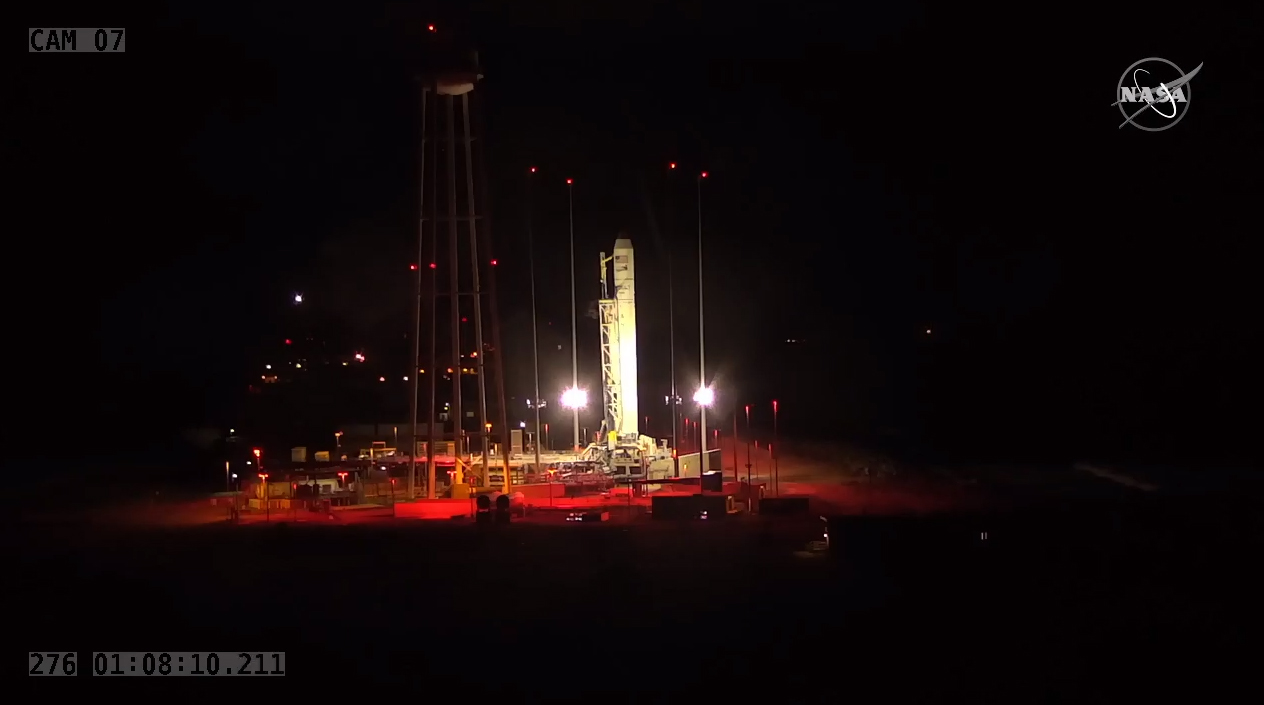Northrop Grumman aborts launch of Antares rocket carrying NASA cargo minutes before liftoff
The next attempt could come as early as Friday night (Oct. 2).

A Northrop Grumman Antares rocket carrying nearly 4 tons of NASA supplies for the International Space Station suffered a launch abort just minutes before liftoff late Thursday (Oct. 1).
The rocket was less than three minutes from liftoff when it experienced the automatic abort while sitting atop Pad 0A of NASA's Wallops Flight Facility on Wallops Island, Virginia. The launch was targeted for 9:43 p.m. EDT (0143 GMT on Oct. 2).
"We have an abort. No launch tonight," NASA spokesperson Rob Navias said in live mission commentary.
The countdown was going smoothly until shortly before liftoff, when flight controllers paused the clock to allow a boat that had encroached inside the keep-out zone around the launchpad to clear the area. That pause led to a five-minute delay in the launch time, shifting from a 9:38 p.m. EDT target to the 9:43 p.m. time. It was after resuming the count that the abort occurred, at 2 minutes and 40 seconds before liftoff.
The abort was triggered due to an "unknown problem" with a piece of ground support equipment and not the Antares rocket or the uncrewed Cygnus cargo ship riding atop it, Navias said.
If Northrop Grumman can determine what triggered the abort quickly, the company could try and launch the Cygnus cargo ship for NASA as early as Friday night (Oct. 2). Liftoff would occur on that day at 9:16 p.m. EDT (0116 GMT).
You can watch the launch live here and on Space.com's homepage, beginning at 8:45 p.m. EDT (0045 GMT), if a Friday attempt does indeed go ahead. You can also watch directly from NASA TV here.
Breaking space news, the latest updates on rocket launches, skywatching events and more!
The Cygnus NG-14 cargo ship launching on Antares is carrying 7,624 lbs. (3,458 kilograms) of food, supplies and experiment hardware for astronauts living on the International Space Station. Chief among that haul is a new space toilet, called the Universal Waste Management System.
As its name suggests, Cygnus NG-14 is the 14th cargo mission for NASA by a Northrop Grumman Antares/Cygnus pair. The company is one of two (SpaceX is the other) currently flying uncrewed cargo missions to the space station for NASA under multibillion-dollar agreements.
The Cygnus NG-14 spacecraft has been named the S.S. Kalpana Chawla in honor of astronaut Kalpana Chawla, who died in the 2003 Columbia space shuttle accident alongside six other astronauts.
Thursday night's launch abort marked the fifth delay of a U.S. rocket launch in the last week, and the third abort in a 24-hour span. On Sept. 24, Blue Origin's suborbital New Shepard rocket suffered a power glitch during a launch try. Separate attempts to launch a United Launch Alliance (ULA) Delta IV Heavy rocket and two SpaceX Falcon 9 rockets also met with delays.
Late Wednesday night (Sept. 30), the ULA Delta IV Heavy rocket carrying the classified NROL-44 spy satellite suffered a launch abort just seconds before a planned liftoff from Cape Canaveral Air Force Station in Florida. On Thursday morning, a SpaceX Falcon 9 rocket had its own abort due to a ground sensor issue while trying to launch 60 Starlink internet satellites from NASA's Kennedy Space Center near the Air Force Station.
SpaceX has another Falcon 9 rocket launch planned for Friday night to loft a GPS III SV04 navigation satellite into orbit for the U.S. military. That mission, which has been delayed by weather and scheduling, is now due to launch from Cape Canaveral Air Force Station at 9:43 p.m. EDT — less than 30 minutes after Northrop Grumman's NG-14 mission, if that one does go up on Friday night.
Email Tariq Malik at tmalik@space.com or follow him @tariqjmalik. Follow us @Spacedotcom, Facebook and Instagram.

Tariq is the award-winning Editor-in-Chief of Space.com and joined the team in 2001. He covers human spaceflight, as well as skywatching and entertainment. He became Space.com's Editor-in-Chief in 2019. Before joining Space.com, Tariq was a staff reporter for The Los Angeles Times covering education and city beats in La Habra, Fullerton and Huntington Beach. He's a recipient of the 2022 Harry Kolcum Award for excellence in space reporting and the 2025 Space Pioneer Award from the National Space Society. He is an Eagle Scout and Space Camp alum with journalism degrees from the USC and NYU. You can find Tariq at Space.com and as the co-host to the This Week In Space podcast on the TWiT network. To see his latest project, you can follow Tariq on Twitter @tariqjmalik.
